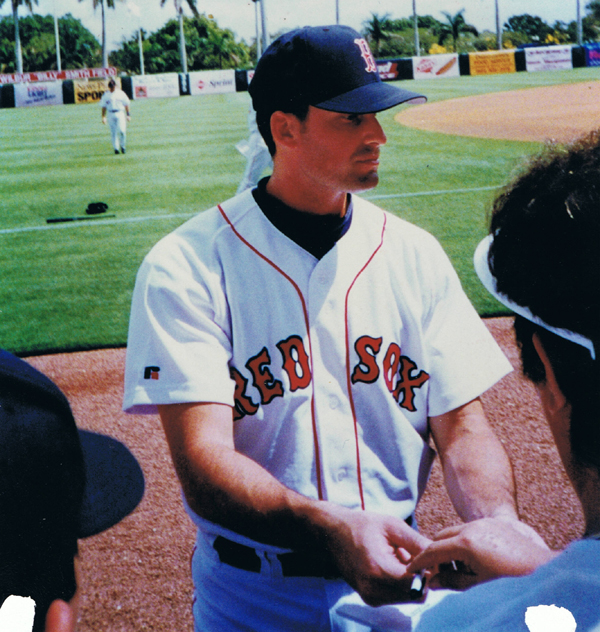What is it like to be the parent of a gifted athlete? Last week I learned a little more when I attended a panel discussion hosted by the Cambridge Center for Adult Education (CCAE).
On the panel were Tom Brady Sr., father of New England Patriots quarterback, Tom, Tom Sr.'s daughter Nancy, a triathlete; and MomsTeam blogger and author of Minor League Mom, Pam Carey, and her son, Todd, who played seven seasons in the minor leagues for the Boston Red Sox. 
Did either Tom, Sr. or Pam have any idea that their sons (Todd's brother, Tim, was also drafted by the Red Sox and played two seasons in the minors before hanging up his spikes) would ever make it to the big leagues. "You know they're good because they keep making it to the next level," remarked Todd and Tim's mom, Pam. "You just want them to have the skills to make the high school team."
Tom Brady agreed; he had no idea if Tom would even continue to play after a disappointing freshman year in high school. Tom was the backup freshman quarterback at his high school in San Mateo, California. "Tommy rarely made it off the bench, never threw a touchdown, and his team never even won a game that season," he said. But he loved football, so Tom Sr. did everything a parent could do to help his son make the most of his god-given abilities, hiring private coaches, sending him to football camps, and producing a recruiting video that Tom Jr. used to earn a scholarship from the University of Michigan.
After he got to Ann Arbor, Tom announced to his family that his goal was to someday be an elite quarterback in the NFL, even though, at the time, he was only the back -up quarterback for the Wolverines. Tom Sr. thought his son was dreaming, but he kept his doubts to himself. "It wasn't my place to limit my child or detract from his dreams. The rough world will do that," he told the audience that was eager to ask questions. "You don't limit their horizons because of your horizons. We got our chance. Now they get their chance."
Like Tom, Sr., Pam Carey never imagined her sons would get as far as getting drafted by the Red Sox and playing in the minor leagues. Her most important job was to make sure her boys got a great education. "There are priorities in life," Carey told me over a cup of coffee before the talk, "one being education." Pam kept her sons on task, never allowing them to watch TV during the school week.
With a master's degree in education from Columbia, Pam was always involved in her sons' school and afterschool activities, including the Boy Scouts and music. She and her husband expected their sons to each bring home "A's." "Our expectations became their expectations and they expected certain things for themselves," she said of her sons.
Whatever they did as parents worked: Both ended up graduating from Ivy League schools, Tim from Dartmouth and Todd from Brown University, and went on to earn graduate degrees, Tim in Asian Studies and International Relations from the University of California at San Diego and Todd an MBA from Bryant University in Rhode Island.
Perhaps the most surprising answers of the night came in response to a question from the panel moderator: "You weren't like any of those crazy out-of-control parents, were you"? Tom, Sr. was quick to admit that, "Yes, yes. I was ... I was all over my kids' sports." (Tom Jr. has three older sisters who grew up being very involved in sports, especially softball). Pam, too, admitted that she was one of "those crazy hockey moms up in the stands being too loud and overly engaged." But Todd was quick to point out that "we put an end to that right away." Although neither Tom, Sr. nor Pam seemed to me to be the pushy or aggressive type, it was clear that their total involvement in their kids' sports was pivotal to their success.
Pam said that, by the time her sons went off to college and then into the minors, she had learned to take a bit of a back seat and step back. Even though she felt she could voice her opinion, she realized then that her role wasn't to be a critic when, one day, after critiquing Todd's play, he proceeded to tell her that she "was ill-informed and should just watch the game." It is good advice, she says, which she now shares with other parents, telling them that "there were coaches to do that. Your role is always that of a supporter, and once you leave that role, it's tough for the child to accept."
I will be writing more on the subject of parenting elite athletes in future blogs. Is your son or daughter a gifted athlete? Are you dreaming that your kids will one day become elite athletes? Do your kids share those dreams? What are you doing to help make those dreams a reality?
I would love to hear from you and share your stories with our viewers.
In the meantime, remember Pam Carey's advice: be a supporter, not a criticizer.